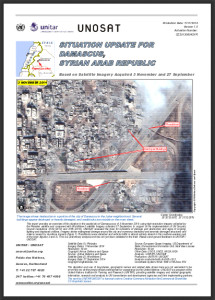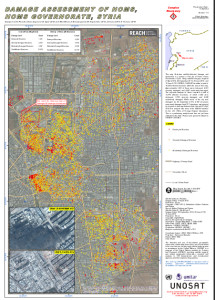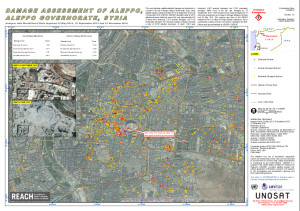
Destruction in the Jobar neighborhood, Damascus. Satellite Imagery made on 3 November 2014. Source: The Operational Satellite Applications Programme (UNOSAT) of the United Nations Institute for Training and research (Unitar).
1. Destruction
The scale of destruction in Syria is quite well documented. It is estimated that over half of the country’s housing units have been completely or partially destroyed since March 2011. In April 2013, the UN Economic and Social Council for Western Asia (ESCWA) reported that one-third of all real estate in Syria (1.2 million houses) had been destroyed by shelling: 400,000 houses were completely destroyed, 300,000 partially destroyed and 500,000 had damaged infrastructure.1
But very few attempts have been made to identify the actual perpetrators of and participants in these alleged war crimes and to distinguish between destruction caused by war hostilities and that carried out for other reasons under the cover of the war.
The Operational Satellite Applications Programme (UNOSAT) of the United Nations Institute for Training and Research (Unitar) has produced a number of reports based on satellite imagery assessing the state of damage and destruction in various Syrian cities,2 in support of the implementation of UN Security Council resolutions 2139 and 2165 of 2014.3 The reports typically review “indicators of damage and destruction and signs of ongoing fighting and displaced civilians.”
One of the reports, from November 2014, provides an overview of the situation in the capital Damascus.4 Satellite imagery shows “widespread damage around the city and numerous destroyed and severely damaged structures and craters caused by munitions impacts.” One of the images shows the north-eastern parts of the neighborhood of Jobar, where several buildings had been destroyed or severely damaged “possibly by air strikes and/or barrel bombing.”
Another report, also published in November 2014,5 documents “numerous severely damaged buildings” in the neighborhoods of ‘Ayn al-Tal, Owaija, Haydariyeh, Hanano and al-‘Urqub in Aleppo caused by the “ongoing fighting.” Few destroyed buildings located in the Ba’aiedin neighborhood showed damages “similar to those observed from air strikes or barrel bombing.” Images of Hanano show buildings that appear to be “severely damaged,” possibly by “artillery and direct fire from tanks and other armored vehicles.”
 In another, city-wide satellite analysis of Aleppo,6 the agency documented a total of 8,510 affected structures, of which 1,543 were destroyed, 4,847 severely damaged and 2,120 moderately damaged. While much of the city had been damaged by the previous analysis in September 2013, 7,937 structures were newly damaged and 17 structures experienced an increase in damage between that date and 23 May 2014.
In another, city-wide satellite analysis of Aleppo,6 the agency documented a total of 8,510 affected structures, of which 1,543 were destroyed, 4,847 severely damaged and 2,120 moderately damaged. While much of the city had been damaged by the previous analysis in September 2013, 7,937 structures were newly damaged and 17 structures experienced an increase in damage between that date and 23 May 2014.
A similar map of parts of Homs 7 identifies a total of 13,778 affected structures, of which 3,082 were destroyed, 5,750 severely damaged and 4,946 moderately damaged. Again, while much of the city had been damaged by September 2013, 4,109 structures were newly damaged and 221 structures experienced an increase in damage between that September 2013 and April 2014.
While these and other maps reveal what appears to be a consistent pattern of widespread and indiscriminate targeting and destruction of civilian structures, using artillery, air strikes and barrel bombs, they do not tell us much about the context and the possible reasons of the destruction. To establish that, one needs to contextualise these figures and maps against reliable news reports or witness statements about what was happening at the time and in the attacks’ aftermath. This would help determine who the perpetrators were and whether or not the destruction was justified by the ‘necessities’ of the war as defined by international law. Only then can we talk about war crimes and crimes against humanity.
For instance, was the destruction of whole neighbourhoods of Homs (two thirds of the city, according to some estimates 8) simply the result of months of siege and fighting between rebel and government forces? As most of the rebels withdrew from the city’s old quarters, in an Iranian-brokered deal in May 2014,9 was the new damage and destruction documented there after that date related to something else? The following sections will show that this may have indeed been the case.
The destruction of Ancient Aleppo
 A satellite-based damage assessment by UNOSAT of Aleppo’s old city, from November 2014,10 documents the total destruction of 22 “heritage locations”, the severe damage of 48 ones, the moderate damage of 33, and the possible damage of 32. Of the 210 locations examined, almost half had sustained damage, while roughly a fifth were completely destroyed.
A satellite-based damage assessment by UNOSAT of Aleppo’s old city, from November 2014,10 documents the total destruction of 22 “heritage locations”, the severe damage of 48 ones, the moderate damage of 33, and the possible damage of 32. Of the 210 locations examined, almost half had sustained damage, while roughly a fifth were completely destroyed.
The study examined “key structures and locations” in Aleppo’s Ancient City, inscribed as “world heritage property” in 1986 and listed by UNESCO in 2013 as “world heritage in danger.”11 The sites included the city’s citadel, the city walls and gates, 73 historic buildings, 83 religious buildings, as well as the city’s historical markets (souqs).
All that the study says about the causes of the destruction is “visible evidence of severe structural damage from shelling impacts and from fire.”
Yet, many of the attacks that caused the damage and destruction are well documented by Syrian opposition and independent media outlets. The Aleppo Media Center alone, for example, has produced tens of videos and pictures of such attacks.12 More systematic research is needed to collect, organise and contextualise such evidence.
Most of the aerial attacks on Aleppo were clearly related to the ongoing armed conflict, even though many of these historical sites were reportedly not being used for military purposes by the rebels. Even if they were, the attacks appear to have been disproportionate and indiscriminate. They were widespread and appear to be part of a state policy of reckless aerial bombardment of all rebel-held or rebel-sympathetic areas in Aleppo. As such, they arguably amount to unlawful, wanton destruction of civilian objects, which is considered a war crime, as detailed in the next chapter. They also arguably amount to a war crime of “intentionally directing attacks against buildings dedicated to religion, education, art, science or charitable purposes, historic monuments, hospitals and places where the sick and wounded are collected, provided they are not military objectives.”13
Notes & References:
1. See here. For more on methodology and how losses are quantified, see, for example, these two local studies: 1 | 2.
2. Available here.
3. Resolution 2139 called on all parties to immediately cease attacks against civilians, facilitate aid delivery and lift the siege of populated areas, including in the embattled Old City of Homs. See here. Resolution 2165 authorised aid delivery across conflict lines and through border crossings, but without enforcement powers under chapter VII. See here.
4. Available here.
5. Available here.
6. Available here.
7. Available here.
8. See, for example, this report by Al-Jazeera (in Arabic) from July 2013.
9. For more on this, see here.
10. Available here. For a more comprehensive report on the destruction of cultural heritage sites throughout Syria, see here.
11. Aleppo is one of the oldest continuously inhabited cities in the world, with some 7,000 years of known settlement history. Due to its long history of occupation, a large number of buildings in and around the original city of Aleppo are “of great historical significance.” Ibid.
12. See the group’s website.
13. See Article 8(2)(b)(ix) of the Rome Statute, available here.
 English
English  فارسی
فارسی  العربية
العربية